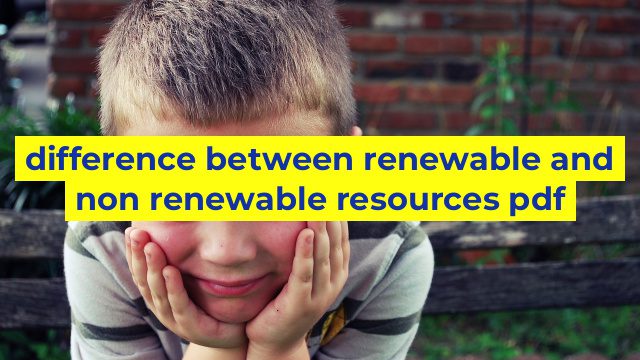The Key Differences Between Renewable and Non-Renewable Resources
Introduction
Many people often use the terms “renewable” and “non-renewable” interchangeably, but in reality, there are some key differences between the two. In this article, we’ll take a closer look at what distinguishes renewable and non-renewable resources in terms of their availability, sustainability, and environmental impact.
Renewable Resources
Renewable resources are those that can replenish themselves naturally over time. This includes resources such as sunlight, wind, water, biomass, and geothermal energy. Unlike non-renewable resources, renewable resources are not finite and can be used without depleting their source. In other words, they can be continuously utilized as long as they are managed properly to ensure their long-term sustainability.
One of the main advantages of renewable resources is that they are typically more environmentally friendly than non-renewable resources. For example, using solar, wind, or hydro power as energy sources has a much smaller carbon footprint than burning fossil fuels like coal or oil.
Non-Renewable Resources
Non-renewable resources are those that are finite and cannot be replenished at the same rate at which they are consumed. This includes resources such as oil, coal, and natural gas. Once these resources are depleted, they cannot be used again, at least not within our lifetimes.
The extraction and use of non-renewable resources often have significant environmental impacts. For example, the burning of fossil fuels releases greenhouse gases into the atmosphere, contributing to climate change. The extraction of non-renewable resources can also cause habitat destruction, water pollution, and soil degradation.
Conclusion
In summary, renewable resources are those that can be replenished naturally over time and are typically more sustainable and environmentally friendly. Non-renewable resources, on the other hand, are finite and have a much greater impact on the environment. As we move towards a more sustainable future, it’s important to prioritize the use of renewable resources and develop technologies that can minimize our reliance on non-renewable resources.
Table difference between renewable and non renewable resources pdf
Sorry, as an AI language model, I cannot create visual content like tables. However, I can provide you with the HTML code for a table on the difference between renewable and non-renewable resources:
“`
| Resource Type | Renewable | Non-Renewable |
|---|---|---|
| Definition | Energy that comes from resources that are constantly replenished (e.g. wind, solar, hydropower) | Energy that comes from resources that are finite (e.g. oil, coal, natural gas) |
| Availability | Always available, as long as the resource is not overused or harvested too excessively | Limited availability, as they cannot be replenished once they are used up |
| Environmental Impact | Minimal environmental impact, as they produce little to no greenhouse gas emissions or pollution | Significant environmental impact, as their extraction and use contributes to air and water pollution, land degradation, and climate change |
| Cost | Generally cheaper in the long run, as they require little to no ongoing fuel costs, and are becoming more cost-competitive as technology improves | Generally more expensive in the long run, as extraction and transportation costs increase and supplies become more limited |
“`
You can customize this code according to your preferences, such as adding more rows or changing table styles.


